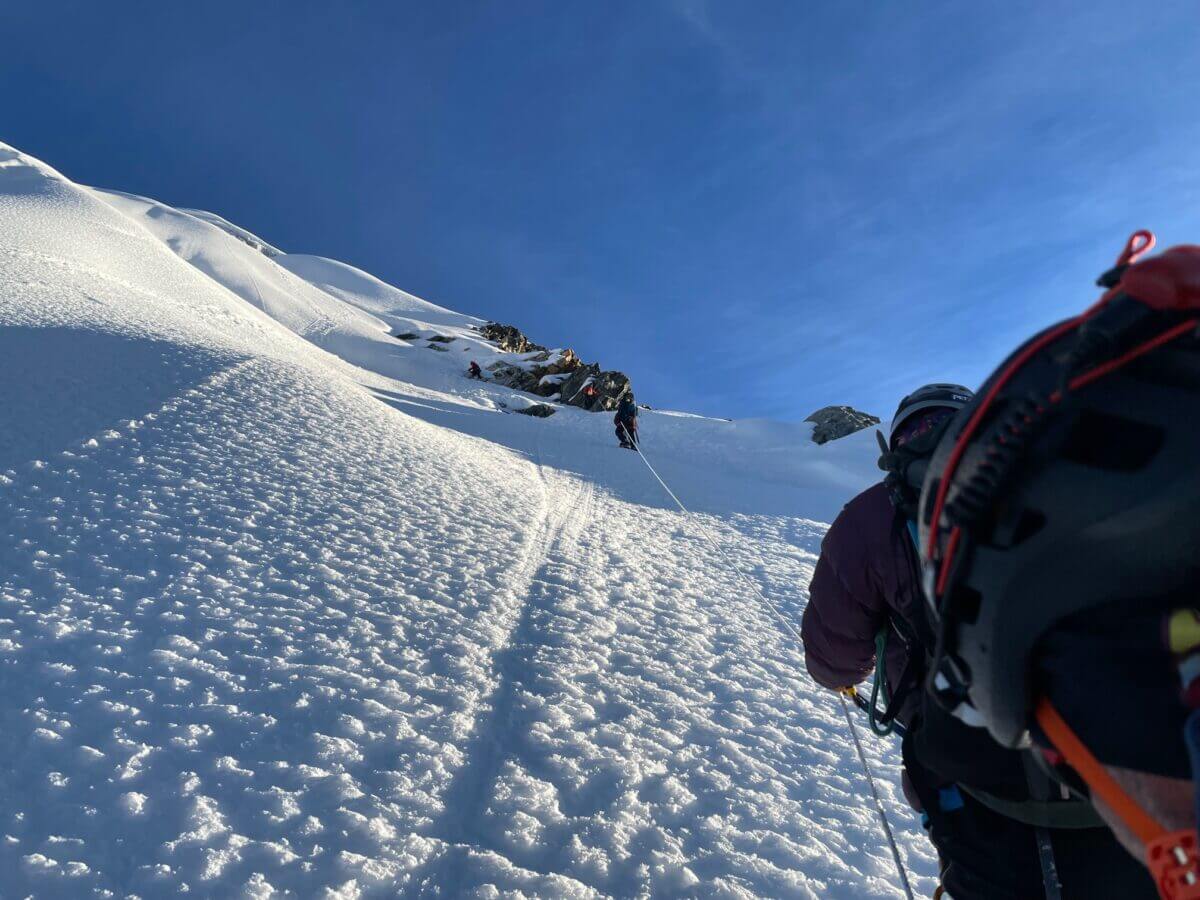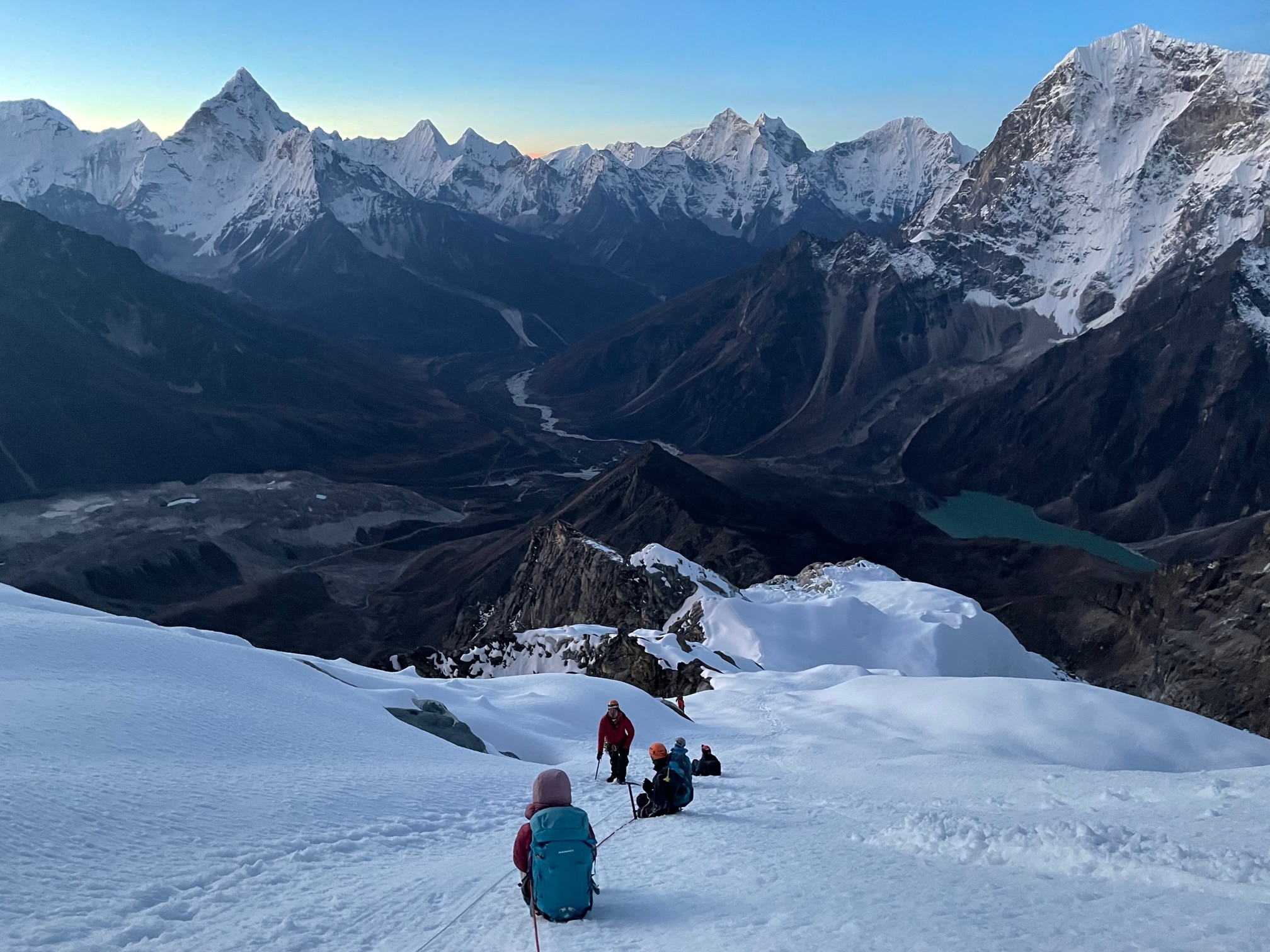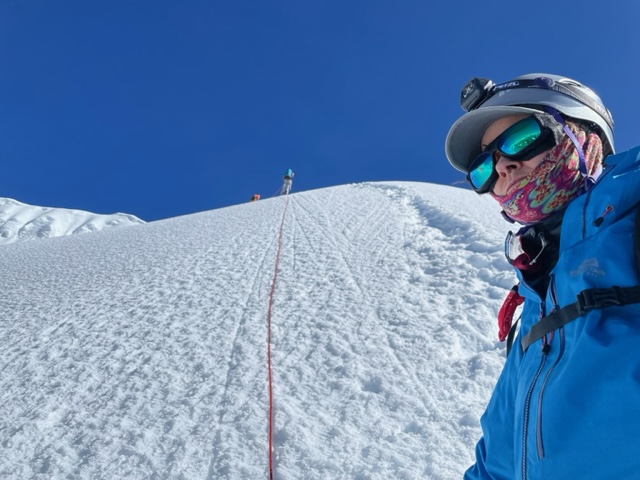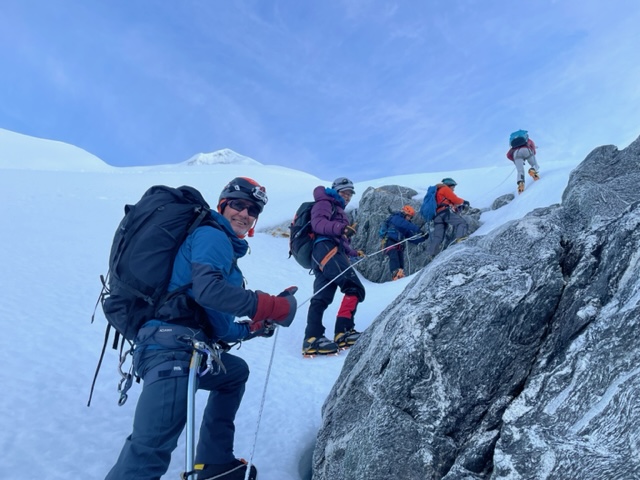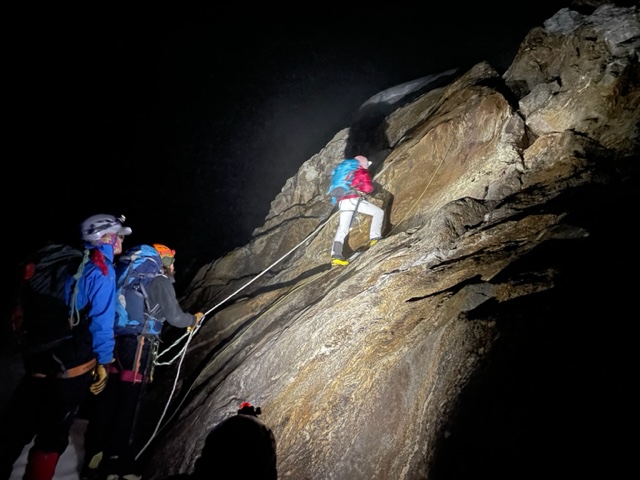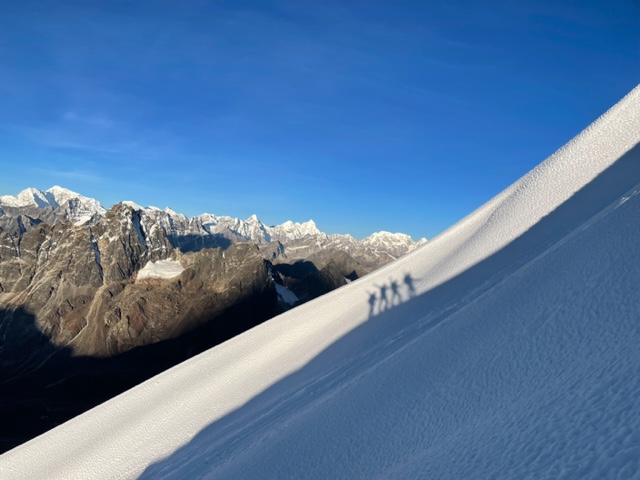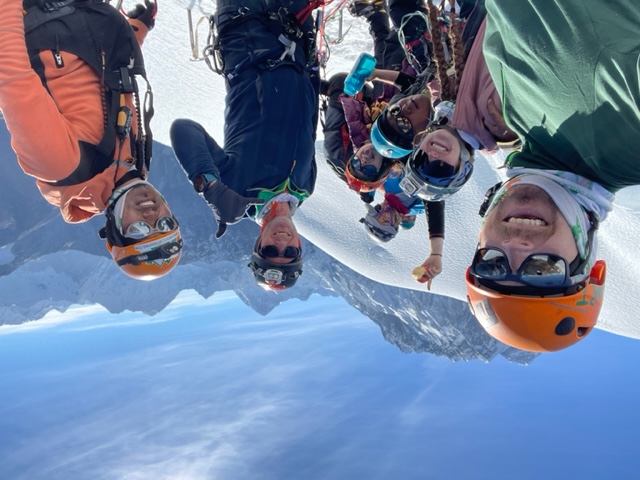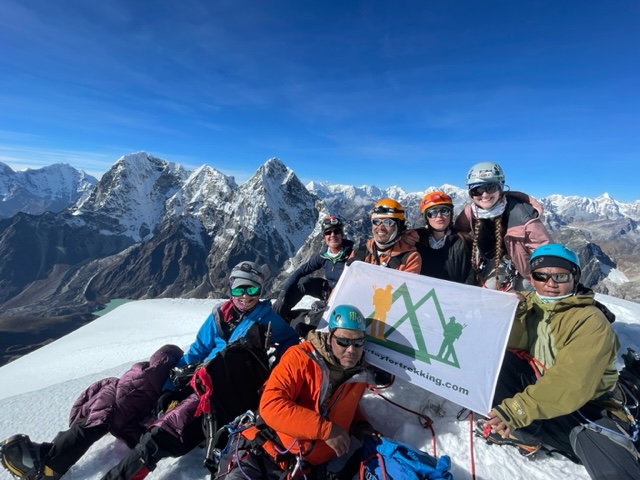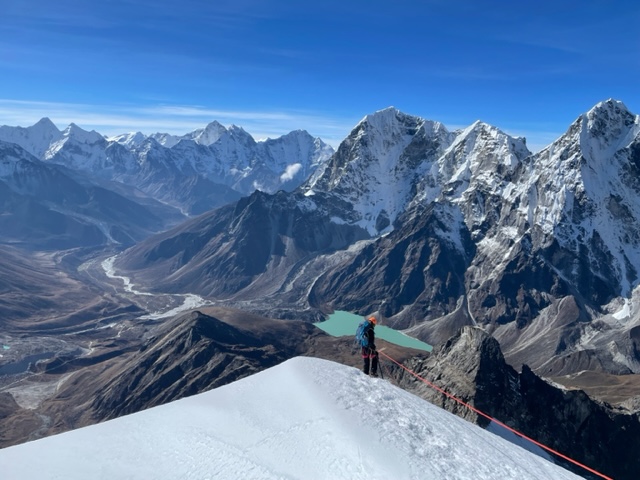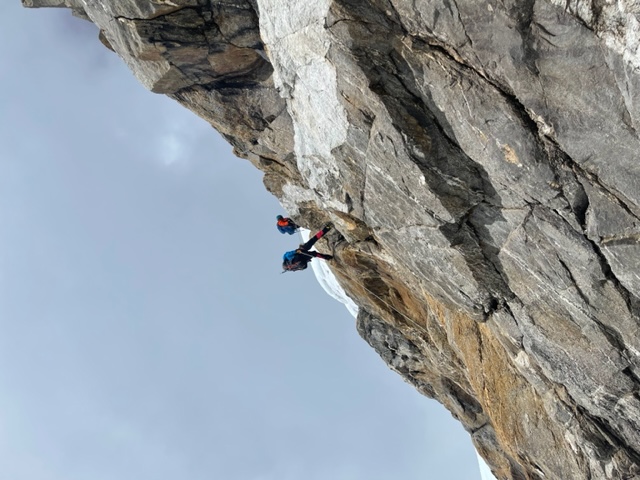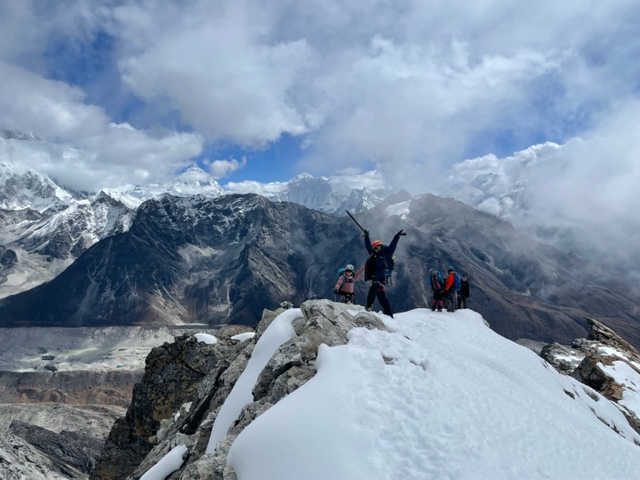We have been leading high quality Lobuche climbs for over 15 years. I have climbed Everest and Lobuche 10+ times. We have the same guides on each trip, bring our own tents, equipment, support team and fix our own ropes where needed. Here are our top 12 tips climbing Lobuche Peak. Check out our itinerary and then our upcoming trips.
How Challenging is Lobuche Peak
Even though Lobuche East is a great intermediate peak to climb in the Everest region. Lobuche should not be underestimated. It is tougher than both Island Peak and Mera Peak.
You need to come fully trained both physically and technically. Lobuche peak requires basic to good knowledge of fixed line mountaineering. We require each person comes with this training. We run these courses in Colorado and Scotland. In addition to fixed line training you need to be familiar with using a harness, crampon and ice axe techniques and cold management.
Our professional team of guides will manage two comprehensive refresher sessions as part of your itinerary. This training will be managed at Lobuche Base Camp.
Fixed Line Mountaineering
You need to be comfortable using a jumar, and most importantly using a figure of 8 moving between fixed anchor points. Our team in Colorado and Scotland are available to get you trained up for the trip. If you’re not sure if you have the experience for this climb, please ask us as we can help advise you.
Physical Training
Interested in a step by step guide get signed up and we can help you understand the training needed. It is important that you are very physically fit and strong. You need to be light, lean and strong for this climb. It is important to do specific training as you will be required to trek on a multi-day basis some days 7 hour back to back and up to 12 hours on the summit day. Being in top shape will ensure you enjoy your climb, feel good throughout and get the most out of the experience.
It is vital that your training closely simulates what you will be doing on the mountain. Traditional gym workouts or general fitness plans aren’t targeted enough. Instead you need to emulate long physical days (6hrs +) in the mountains.
Getting Started
Depending on your current training, you may need anywhere from 3 to 6 months to get physically prepared. In my opinion you will need to build up to training 5/6 days per week. Supplement your daily gym training in targeted heart rates with longer endurance based training. You also need to consider the weight you are carrying in your backpack. We recommend building up to carrying 11kg/ 25lbs.
By the end of your training you should be comfortable training back to back day with weight on a stair master, 30% incline treadmill for 1 hour 30 minutes in zone 2/3 getting in 1,800 feet to 2,000 feet of elevation. Alongside a longer 8 hour hike covering over 3,300 feet of elevation up and down with a weighted backpack.
1). More Acclimatization on the right Itinerary
Having a balanced itinerary consisting of ample acclimatization, rest and contingency days is essential. We have designed the best itinerary with the correct acclimatization with recommended elevation gain per day. We have 3 nights in Namche on the way up the trail to optimize acclimatization in the early stages of the trip.
You will need at least 3 weeks for the Lobuche peak climb. Do not cut short the itinerary in any way. You will find several companies offering 2 weeks expedition to Lobuche peak. Without acclimatization you have nothing. A longer itinerary may be difficult for you to afford due to your work and personal circumstance but this is the right way to climb.
Our Lobuche climb is combined with a trek into Everest base camp and Kala Patthar 18,820 feet.
Even strong and experienced climbers are forced to turn back if they do not follow proper acclimatization.
2). Have the Right Clothing and Gear
With temperature ranging from + 20c to – 15c (68F to 5F), you need to come prepared. Once you arrive in Lobuche Peak Base Camp, there are no lodges, therefore you will be sleeping in tents, out in the elements. Having the right gear can be the difference in a successful and unsuccessful trip.
Two essential pieces of gear will be a high quality down coat and high quality sleeping bag. You will need to wear this down coat in the mornings and evenings as well as during your summit attempt.
Wearing high quality base layers is another way to ensure you are managing your body temperature. We like to recommend Merino Wool as a great option for base layers, however they can be quite expensive, so if you are not looking to spend that much on your layers, you could also look at synthetic pieces.
You should stay away from anything cotton against your skin. Cotton will be very difficult to dry and it will also not help with regulating your body temperatures.
Other important items for Lobuche Peak will be your mountaineering boots and gloves. Keeping your hands and feet warm is extremely important. CLICK HERE and watch our packing video. If you sign up to one of our trips we send you a 40 page dossier with itemized kit list. READ SOME REVIEWS.
3). Physical Training for Climbing Lobuche Peak
Lobuche peak is considered a technical peak consisting of mixed climbing, although many people still choose it for their first Himalayan climb.
Training well ahead in advance can help you greatly. The fitter you are, the more enjoyable your climb will be. The 3 weeks journey to the summit of 6119m peak and back is a challenging task. Training well ahead in advance is the best tip for climbing Lobuche east peak.
Your journey to Lobuche begins before you set foot in Nepal. Do your training on steep rough ground, off-trail, and even scrambling. This will not only help you to train your fitness level but also provides you with the knowledge of the similar route you are going to tread.
Start with general conditioning training to improve your fitness level and aerobic capacity. This will greatly improve your performance level and provide you with a base for more specific training.
Finally, you should do specific training for peak climbing. Specific training would be like climbing a smaller mountain in your region. You should also carry a heavy backpack and wear mountaineering boots when climbing peaks for specific training.
4). Mountaineering Experience
Lobuche peak is graded Alpine PD+ on an alpine grading system with a route consisting of 45 Degree snow slopes and exposed ridge climbing. Lobuche Peak Climb offers a more technical feel to the climb.
Use of climbing equipment is required and you should be comfortable walking with the crampons. On a guided climb, there will be a guide to assist you and provide you with instructions on skills relative to the climb.
Most of the section on Lobuche peak is fixed-roped. Having a basic knowledge of fixed ropes and crampons is greatly beneficial.
5). Climbing Course and Preparation
Schedule one full day just for the climbing course or refreshment training. A good briefing and talking will not be enough while climbing a peak, especially when it requires the use of climbing gears.
Demonstration of equipment, using the equipment correctly, knowing the risks involved, and learning simple life-saving techniques are vital. You might have acquired basic skills and learned techniques for peak climbing, but, each peak may require a different set of skills and techniques.
A climbing course before the actual climb will help you in knowing the terrain and using the equipment correctly and efficiently. If you are an experienced climber, it still will not hurt to keep a day as a refreshment training.
6). Buy your own Mountaineering Boots Early
If you have ever worn mountaineering boots before, then you will understand what I mean here! Mountaineering boots are extremely rigid and heavier than your normal trekking boots, making them a lot more difficult to walk in.
It is essential that you have worn-in your boots before you go, and also that you pick the correct boots. Your feet are so very important to your success on Island Peak, and you need to look after your feet at all times in the Himalaya’s.
Island peak base camp is 80 miles from a road, you are in a wilderness area and need to be fully prepared with the right boots. This is not the place for you to test out your mountaineering boots. Likewise, we strongly advice against renting mountaineering boots. Having the wrong boots or renting boots could ruin your feet and your trip.
7). Manage your Safety Throughout the Trip
The trail to Island Peak comes with some hazards. You need to be aware of these prior to making this journey. Our guides will lead you safely through the trail but always be aware of landslide regions, drop offs, people, yaks, and mules.
Always stay on the mountain side of the trail when passing or being passed, and constantly be aware of your surroundings.
CLICK HERE for our top tips while you are on the Everest trail towards Island Peak. Always wear a helmet above high camp as there is potential rock fall. You need to take personal responsibility for your own safety and be mindful of your surroundings.
8). Have Qualified Climbing Guides
Unfortunately, there are a lot of local guiding companies out there that offer Lobuche Peak climbs who are not qualified to do so. Many companies out there will promise you the world, however they outsource their services to guides in Dingbouche and Lobuche.
These guides have limited climbing experience and will not have the ability to fix ropes or manage clients at high altitude. You need to make sure you have done your research on the company you will be using. You should have a professional climbing Sherpa who can fix ropes, manage technical training at Lobuche Base Camp.
We bring our own ropes up the mountain and fix them each trip for your safety. Therefore, we do not use the ropes that are already fixed to the mountain. These ropes that are already there are used by too many people.
They are not checked regularly enough to be safe in our opinion. We also use a high camp at 5,500m/ 18,045 feet, which gives you the best possible chance at a safe and successful climb to the summit of Lobuche Peak.
9). Get Helicopter Evacuation cover and Insurance
We require that you have Helicopter evacuation cover along with an insurance before doing any adventurous activities. Peak climbing in Nepal involves different risks and having Insurance that will cover you during any unprecedented event is life-saving.
Make sure you check with your insurance provider if they cover peak climbing activity in Nepal and be sure to include helicopter evacuation and trip cancellation on your coverage.
10). Have Previous Altitude Experience
There is a massive investment that you have made to do Island Peak. You have spent the money, time, and preparation to go all the way to Nepal and climb. Everyone acclimatizes differently, therefore, knowing how you adapt at altitude helps you in your understanding and preparation for this climb.
Having made numerous treks and possible climbs at altitude will help you in your preparation for Lobuche Peak.
How do you know what it is going to be like at 5,000m/ 16,404 feet and above, with 50% less oxygen, if you have never been at this elevation before? Be responsible and take the right path to 6,000m/ 20,000 feet peaks.
11). Know Your Knots
When you are climbing Lobuche Peak, you will need to know how to tie different climbing knots. The figure of eight, overhand knot, Alpine butterfly and Italian Hitch knots will be used in the training and preparation for Lobuche Peak.
Therefore, it is best if you know these and have practiced these knots prior to joining a Lobuche Peak climb. We will have rope with us on the trek in, and we will help you become more proficient on the route to Lobuche Peak.
12). Be Proficient in Rappelling with a Figure of 8
As you will see in the video above, you have to abseil down the Head-Wall of Island Peak. You will be in control of the rope as you abseil down. Therefore, being comfortable with abseiling prior to the start of the trip will be essential.
We recommend doing an outdoor course before the trip. This should include learning how to move from one rope to another on steep terrain, using a figure of 8 device. You should also be comfortable with exposure.
Therefore, finding a local climbing wall and practice using a harness and abseiling from high, which will help build confidence and experience for when you need it high on Island Peak.
How Steep is Lobuche East
Lobuche East is known for its steep and challenging terrain, especially towards the summit. The ascent involves negotiating steep ridges, rocky sections, and possibly some icy slopes depending on the season and route taken. You do need to be competent in fixed line climbing.
How High is Lobuche
Lobuche Peak stands at an elevation of approximately 6,119m/ 20,075 feet above sea level. Our Base Camp below Lobuche village sits at 4,900m/ 16,076 feet and High Camp is positioned at 5,200m/ 17,060 feet.
Climbing Grade of Lobuche East
The standard route on Lobuche East is graded as PD+ in the alpine grading system. This indicates that it requires some technical climbing skills, including the use of ice axe and crampons, as well as proficiency in rope management and glacier travel.
Cost of Climbing Lobuche
The cost of climbing Lobuche Peak can vary depending on factors such as the expedition duration, guiding services, permits, equipment rental, and logistics. It is also important to have the best guides and this costs more. On average, a guided climb of Lobuche Peak can range from $3,000 to $7,000 per person.
The Cost of Climbing Everest
Climbing Everest is significantly more expensive compared to Lobuche Peak due to its higher elevation, longer expedition duration, and more complex logistics. The cost of climbing Everest can range from $35,000 to $120,000 or more per person, depending on the expedition operator and services included.
Training for Lobuche East
Training for Lobuche East should include a combination of cardiovascular exercises, strength training (especially focusing on legs, core, and upper body), endurance training, and altitude acclimatization. Specific training should include hiking with a weighted pack, climbing on steep terrain, practicing rope techniques, and simulated altitude training if possible.
Technical Difficulty of Lobuche Peak
Lobuche Peak is considered moderately technical. While it does not require extensive mountaineering experience, climbers should have basic rock and ice climbing skills, as well as familiarity with using climbing equipment such as harnesses, ropes, ice axes, and crampons.
Suitability for Beginners
While Lobuche Peak is technically feasible for beginners with some prior training and guidance from experienced mountaineers or guides, it is essential for beginners to have prior experience in high-altitude trekking and some basic climbing skills. It is not recommended as a first-time mountaineering objective without adequate preparation.
Next Climbing Objectives after Lobuche Peak
After successfully summiting Lobuche Peak, climbers may consider tackling other peaks in the Himalayas such as Mera Peak, Cholatse or Ama Dablam. These peaks offer varying degrees of technical difficulty and altitude challenge, providing climbers with opportunities to further develop their mountaineering skills.
Respect our Guides
Last but not least on our top 12 tips for Lobuche peak climbing is to listen to our guides. Our lead guides have a wealth of knowledge and experience. Their primary function is to manage your and team safety.
Climbing a peak involves various factors that can cause fluid situations and may present you with difficult times. Each climber’s experiences will be different while climbing. The thin air at high altitudes affects everyone differently. You should always listen to your guide’s advice and if they tell you to turn around you must follow their instruction.
Listen to your body and how it is dealing at altitude. Prepare yourself accordingly and always seek advice from the guide. We will check your oxygen saturation and heart rates morning and night to see how you are adjusting to the lack of oxygen as we move higher.
Join the Experts
In 2019, we won the International Tourism Award in Nepal for running the best itineraries with the best support for our teams. We have our own office in Kathmandu with full time staff on the ground.
We have designed our itinerary and service for optimal success. All you have to do is come prepared and you can make it to the top! These are our top 12 tips for Lobuche peak climbing were useful, but feel free to reach to our team today.

